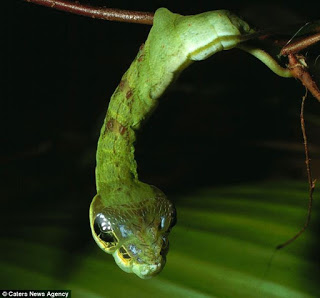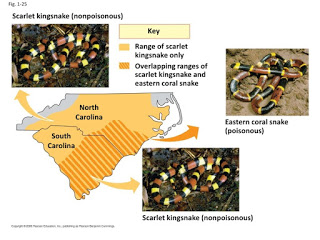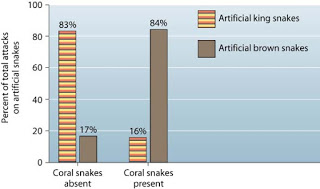The Art of Disguise
Animals will often use the coloration of their skin and/or fur as a defense mechanism. The most popular use of this is camouflage, in which organisms blend into their surround environment to avoid being detected. Another way that animals can use coloration to avoid confrontations is mimicry. In biology, mimicry is the superficial resemblance of one organism to another which is not closely related (“Wickler”).
For example, the caterpillars of hawk moths have developed the ability to mimic the appearance of a snake in order to protect itself from predators. When threatened, the caterpillar will throw back its head revealing its ventral side (Hossie). This portion of the caterpillar’s underbelly is capable of inflating into a three-dementional diamond shape similar to that of a snake’s head (Chambers, Hossie, Mok). It also features a couple of eyespots, dark pigmented dots that appear to be eyes, to complete the look (Chambers, Griffiths, Hossie, Mok). In addition to its appearance, the hawk moth caterpillars have also adapted to exhibit the behavior of striking its head in a fashion that resembles an attacking snake (“Animal Mimicry”, Griffiths, Hossie, Mok).

Another way that animals use mimicry for defense is by exploiting another specific form of coloration found in the animal kingdom called aposematism. Aposematism or aposematic coloration is the use of strikingly, conspicuous coloration and patterns by poisonous animals to warn other animals that they are dangerous. As a result, other animals avoid approaching or eating organisms that demonstrate aposematic coloration. There are two specific sub-classes of mimicry in which other animals copy this “fashion trend” in order to reap the benefits of not being predated themselves. These are known as Batesian and Müllerian mimicry (Ricklefs et al. 2015).


and Pfennig published in Nature. Photo Credit: Campbell Biology.
In Batesian mimicry, a non-poisonous or -venomous animal utilizes the aposematic coloration of another animal that is actually dangerous (Ricklefs et al. 2015). In doing so, predators that have learned to avoid the copied organism because of their coloration, also avoid the organism that is practicing mimicry. There are two species of snakes in North and South Carolina that demonstrate this type of relationship. The eastern coral snake is venomous with colored rings of black, yellow, and red repeated in that order along its length. Living alongside the coral snake is the scarlet kingsnake which also has a body with black, yellow, and red stripes but in a different order. The scarlet kingsnake, however, is not venomous demonstrating this color scheme as a mode of Batesian mimicry that has been proven to work in its favor (Reece et al. 2011).
In a study conducted in 2001, researchers at the University of North Carolina examined the predation rates on scarlet kingsnakes in environments both in the presence and absence of coral snakes. Decoys of scarlet kingsnakes and of generic, brown-colored snakes were placed in both types of environment to be monitored. The results showed that predation of the scarlet decoys occurred less often in the coral snake habitats compared to those where coral snakes were not present (Pfennig, Harcombe, and Pfennig 2001; Reece et al. 2011). In the absence of the model, the dangerous coral snake, predators in that area had not come to associate that coloration scheme with danger (Pfennig, Harcombe, and Pfennig 2001; Reece et al. 2011). As a result, the scarlet kingsnake decoys were attacked more often when coral snakes were not around to impart this awareness in the wildlife community (i.e. by killing or harming individuals that would later serve as an example to others) (Pfennig, Harcombe, and Pfennig 2001; Reece et al. 2011). This experiment demonstrates how the system of mimicry works in nature.
An entire insect family also utilizes this form of mimicry within the order Diptera, which is composed of the flies (“Hover Fly”). The flies of this family, Syrphidae, are called Hover or flower flies and all 6,000 species demonstrate Batesian mimicry (“Hover Fly”). Hover flies have abdomens with black and yellow stripes that make them appear to be bees or wasps. By having this appearance, Hover flies deceive other organisms into believing that they are actually these hymenopteran insects capable of stinging any other animals that disturb them (“Hover Fly”, Ricklefs et al. 2015). Other organisms consequently avoid Hover flies for fear of being stung. The different species of Hover flies can be found across the globe. Ceriana vespiformis is found in the area of the Mediterranean with a range stretching from Portugal to Israel and Lebanon and longitudinally from as far north as the Netherlands to North Africa (Reemer). Eristalis tenax is a cosmopolitan species that can be found in the hospitable habitats of every continent except Antartica (Metcalf, Thompson). Finally, Syrphus ribesii is found across the northern hemisphere from Alaska throughout Europe to Japan (Peck, “Syrphus Ribesil”).
Müllerian mimicry works similarly to Batesian mimicry in which one species of organisms adapts its coloration in order to exploit the fact that a community has already come to associate a certain bright, color scheme as a warning by another species. The difference with Müllerian mimicry, though, is that the species that is mimicking the original is also dangerous, either being poisonous or venomous itself. An excellent example of this is Ranitomeya imitator, the mimic poison frog. The mimic poison frog is a single species of poison frog found in Peru that like all other species of poison frog are poisonous to organisms that ingest them and display aposematic coloration. The mimic poison frog has several different aposematic coloration morphs, compared to the one or at most two used by all the individuals of a single species of poison frog. Each of these different morphs of the mimic poison frog mimics the coloration of another species of poison frog, hence its name. By this system, the mimic frog can have a different color and pattern of skin that depends on the other species of frogs that it shares the same environment. In the presence of the red-headed poison frog, the mimic frog will have an orange/red upper body and blue legs with small dark spots. When it shares habitat with the Summers poison frog, the mimic has bold patches of yellow/gold and black. When around splash-back poison frogs which have two color morphs (spotted and striped), the mimic frog will be either all green with black blotches or have a yellow, striped upper half and a green-blue lower body with black spots, respectively. By adapting to its habitats in this way, the mimic poison frog is able to survive over a larger range than any of the poison frog species that it mimics, which may play a role as to why its populations are the least at risk at becoming extinct (Ricklefs et al. 2015).
• • •
REFERENCES
Chambers, Delaney. “‘Two-Headed Snake’ Shocks Homeowner.” National Geographic. National Geographic Society, 26 Mar. 2017. Web. 18 Apr. 2017. <http://news.nationalgeographic.com/2017/03/caterpillar-hawk-moth-snake-eye-animals/>.
Griffiths, Sarah. “The Best of Nature’s Disssssguises You’ll Ever See: The Caterpillar That Looks and Even Acts like a Snake to Scare off Predators.” Daily Mail Online. Associated Newspapers, 28 May 2014. Web. 18 Apr. 2017. <http://www.dailymail.co.uk/sciencetech/article-2641537/The-best-disssssguise-Caterpillar-looks-acts-like-snake-scare-predators.html>.
Hossie, Thomas. “Possibly the Best Known Eyespot Caterpillar: Hemeroplanes Sp. (Sphingidae).” Caterpillar Eyespots. N.p., 26 Jan. 2012. Web. 19 Apr. 2017. <http://caterpillar-eyespots.blogspot.ca/2012/01/possibly-best-known-eyespot-caterpillar.html>.
“Hover Fly.” Encyclopædia Britannica. Encyclopædia Britannica, Inc., 07 Aug. 2009. Web. 22 Apr. 2017. <https://www.britannica.com/animal/hover-fly>.
Metcalf CL. 1913. The Syrphidae of Ohio. Ohio State University Bulletin 17: 1-123.
Mok, Kimberley. “Nature Blows My Mind! Caterpillar Mimics Snake Behavior to Scare Predators (Video).” TreeHugger. Narrative Content Group, 24 May 2014. Web. 18 Apr. 2017. <http://www.treehugger.com/natural-sciences/nature-blows-my-mind-caterpillar-looks-like-snake-hemeroplanes-triptolemus.html>.
Peck, L.V. (1988). “Syrphidae”. In: Soos, A. & Papp, L. (eds.). Catalogue of Palaearctic Diptera 8: 11-230. Akad. Kiado, Budapest.
Pfennig, David W., William R. Harcombe, and Karin S. Pfennig. “Frequency-dependent Batesian mimicry.” Nature 410.6826 (2001): 323-323.
Reece, Jane B., Lisa A. Urry, Michael L. Cain, Steven A. Wasserman, Peter V. Minorsky, and Robert B. Jackson. “A Case Study in Scientific Inquiry: Investigating Mimicry in Snake Populations.” Campbell Biology. 9th ed. San Francisco, CA: Pearson, 2011. 20-22. Print.
Reemer, M., and B. Van Aartsen. “”Ceriana Vespiformis, Een Nieuwe Zweefvlieg Voor De Nederlandse Fauna (Diptera: Syrphidae)”.” Nederlandse Faunistische Mededelingen. 2001. 11 (1): 133-36. ISSN 0169-2453. PDF.
Ricklefs, Robert E., Rick Relyea, and Christoph F. Richter. Ecology: The Economy of Nature. 7th ed. New York, NY: W.H. Freeman and, a Macmillan Higher Education, 2015. Print.
“Syrphus Ribesii.” Wikipedia. Wikimedia Foundation, 10 Feb. 2017. Web. 21 Apr. 2017.
Thompson CE. (1999). Flower Flies. United States Department of Agriculture, The Diptera Site. http://www.sel.barc.usda.gov/diptera/syrphid/syrphid.htm (5 February 2009).
Wickler, Wolfgang J.H. “Mimicry.” Encyclopædia Britannica. Encyclopædia Britannica, Inc., 01 Dec. 2000. Web. 18 Apr. 2017. <https://www.britannica.com/science/mimicry>.













